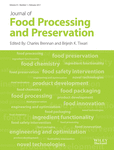Development of a Combined Osmotic Dehydration and Cryogenic Freezing Process for Minimizing Quality Changes During Freezing with Application to Fruits and Vegetables
Abstract
The effect of a combined osmo-dehydro-cryogenic-freezing process on quality characteristics of fruits and vegetables was evaluated. Cut-tomato-pieces were used as a model vegetable to evaluate the process. Tomatoes had 15.74% water loss and 0.22% solids gain after 24 h of osmotic dehydration in a 55% (w/w) maltodextrin solution at 35C, and increased redness was observed in osmotically dehydrated samples with lycopene content of 1244.78 µg/g of dry mass. Under liquid nitrogen cryogenic freezing at −40C osmotic pretreated tomato samples had shorter freezing time (3.13 min) and higher freezing rate (16.53C/min) than untreated samples (4.48 min and 11.58C/min, respectively). Pretreated-thawed tomato samples had less drip loss, higher retention of color and lycopene than untreated samples after thawing. Pretreated-thawed tomato samples had less cell collapse than untreated-thawed samples. This study demonstrated that osmotic pretreatment could improve color, reduce nutritional quality loss, and texture degradation of tomatoes during cryogenic freezing.
Practical Applications
A pre-freezing process such as osmotic dehydration may help to reduce quality loss of fruits and vegetables during cryogenic freezing as a result of removing part of the water. In this study, a combined osmo-dehydro-cryogenic-freezing was developed for minimizing quality changes of fruits and vegetables during freezing. Cut-tomato-pieces were used as a model fruit to evaluate the process. Quality characterization was carried out by evaluating the lycopene content, color and cell structures of osmotically dehydrated frozen samples. We found that the combined osmotic dehydration and cryogenic freezing reduced the quality loss of tomato samples when compared to the same freezing process without any pretreatment. This combined process of osmotic dehydration and cryogenic freezing can be applied to produce high quality commercially frozen fruits and vegetables.




